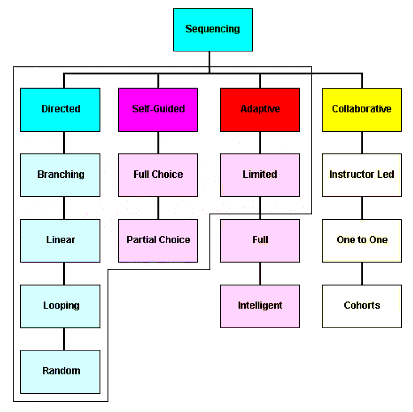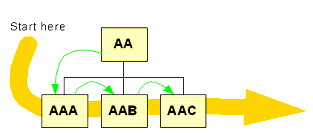IMS Simple Sequencing: Difference between revisions
m (→Tools) |
mNo edit summary |
||
| Line 98: | Line 98: | ||
[[Category: Standards]] | [[Category: Standards]] | ||
[[Category:XML]] | [[Category:XML]] | ||
[[Category:E-learning tools]] | [[Category:E-learning tools]] | ||
[[Category:Educational modeling languages]] | [[Category:Educational modeling languages]] | ||
Revision as of 14:29, 9 July 2009
Definition
- IMS Simple sequencing is an educational modeling language to define learning sequences.
- The IMS Simple Sequencing Specification defines a method for representing the intended behavior of an authored learning experience such that any learning technology system (LTS) can sequence discrete learning activities in a consistent way. The specification defines the required behaviors and functionality that conforming systems must implement. It incorporates rules that describe the branching or flow of instruction through content according to the outcomes of a learner's interactions with content. The Specification was released to the public in March 2003." ( Content Packaging Specification )
- Simple sequencing implies a fairly classic behaviorist "instructional design model", like mastery learning, programmed instruction, Gagne's nine events of instruction.
Overview
This only provides a short summary. Simple sequencing is not simple. It's a quite powerful language within its domain of application.
Simple Sequencing and Content Packaging
- The IMS Simple Sequencing Specification was developed to allow sequencing descriptions to be embedded within a IMS Content Packaging manifest file using the XML namespace extension set aside for IMS Simple Sequencing. In other words this means that as an author all you need is a tool that fully implements IMS Content Packaging + Simple sequencing extensions. You then can "run" your content within a Learning technology system, e.g. an LMS.
- Each <organization> element in the content package is a content aggregation. It represents the root of an activity tree - it is also an activity. Nodes (i.e. <item> elements) are activities (that can in turn contain sub-activities). Therefore an item can represent a module, a lesson, a content, a quiz, etc.
Documentation
- IMS Simple Sequencing Best Practice and Implementation Guide - Version 1.0: This document provides an overview and describes how the IMS Simple Sequencing Information Model and XML Binding can be applied to specific types of interoperability scenarios. This is the best place to start, but also contains very technical reading.
- IMS Simple Sequencing Information and Behavior Model - Version 1.0. This document describes the data structures in detail. More difficult technical reading.
- IMS Simple Sequencing XML Binding - Version 1.0. This document describes how to encode the sequencing objects in XML and provides the corresponding XML schema; Technical Manual to be consulted together with the previous documents.
Scope of IMS Simple Sequencing
According to IMS Best Practice Guide 1.0, the "Simple Sequencing Specification addresses a small but productive segment of the entire problem space for learning content sequencing. The IMS Simple Sequencing Specification relies on the concept of learning activities. A learning activity may be loosely described as an instructional event or events embedded in a content resource, or as an aggregation of activities that eventually resolve to discreet content resources with their contained instructional events."
The IMS definition of a learning activity is in our opinion related to the concept of mastery learning or similar instructional designs. According to the best practice guide, " a Learning Activity is a pedagogically neutral unit of instruction, knowledge, assessment, etc. It can have sub-activities and may be nested to an arbitrarily deep level. Each activity may have a tracking status associated for each learner that is assigned to experience the activity. Activities can be attempted any number of times, or the number can be specified. They can be suspended, abandoned, exited normally, etc. All activities are performed within the context of a parent activity.
Activity Tree
Activities are arranged in the form of a tree, each node an activity. LMS sequencing behavior is described in terms of traversing the nodes of the tree to determine which activity to deliver to the learner. The default traversal rule is pre-order, but it can be modified through the association of sequencing rules created by a learning designer.
Traversal is triggered by the learner through navigational events or by the delivery system itself. Sequencing rules are evaluated at runtime and can be conditional based on tracking status.
Activity Clusters
A cluster is a root node and its immediate children and sequencing rules always refer to such a cluster.
Unless otherwise specified, a learner is allowed to choose any sub-activity in a cluster but more complex flows can be specified.
Rule-based sequencing
One can assign rules to any node at different levels. E.g. some nodes can be skipped under certain conditions. The rule langage is quite complex (at least for hand-editing). The technical manual ([1]) exceeds the equivalent of 100 print pages.
The Sequencing Loop
The sequencing behavior process (i.e. the activities/contents delivered to the learner) is defined by the activity tree and its associated sequencing rules.
A sequencing session is started when the learner logs in and selects a course or a module (i.e. he also can resume a previous session or make a certain choice).
The Sequencing Definition Model
(to be written ....)
Tools
- IMS Simple Sequencing is part of the SCORM 2004 edition. See also IMS Content Packaging
- The SCORM Website maintains a list of certified systems and test suites (difficult to sort out).
Few Simple Sequencing capable systems seem to be in use in higher education as far as I can tell (UTC). Is there somewhere a usable list of operational systems. I have the impression that this standard is ignored - Daniel K. Schneider 20:06, 18 February 2009 (UTC) ??
- I have the impression that SCORM 2004 compliance does not necessarily mean that Simple sequencing is implemented.
- ADLCommunity.net may have some information ...
Discussion
Please be aware that this article is really incomplete. Also the author lacks true field experience with IMS Simple sequencing. So, this discussion is very provisional.
Some critiques when confronted with e-learning talk about "spray and pray method", shovelware, or "page turning" and that reflect how sometimes e-learning is implemented. Many so called learning objects are in fact just simple IMS content packs or not very sophisticated SCORM 1.2 packs (e.g. that just allow tracking).
However, within a Simple Sequences compatible LMS you can implement designs that do respect some pedagogical standards, e.g. Mastery learning. Therefore, DSchneider thinks that Simple Sequencing is not simple (!) and that producing pure shovelware within the IMS/Scorm universe is not an obligation. Simple sequencing covers an important gap, i.e. allows us to produce high-quality CBT over the internet. Its scope is certainly limited, but then the specification says so :)
- See also IMS Learning Design which is another IMS standard. IMS LD (in particular level C) has a wider scope than IMS SS. Its authors make universal claims, but Daniel K. Schneider doesn't buy that. No current modelling language can seriously pretend to cover all kinds of pedagogic strategies and models
Links
References
- Standards
- Introductions
Warwick Bailey (2005) What is IMS Simple Sequencing?, JISC/CETIS, PDF

